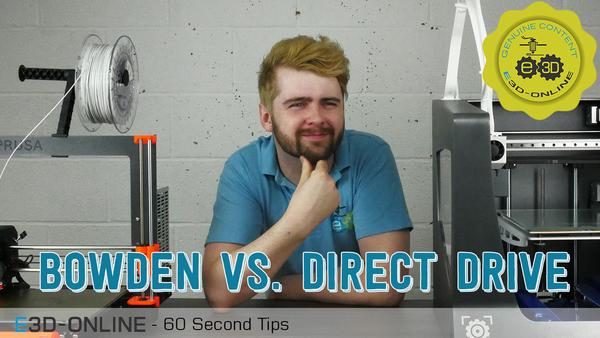In all honesty, 3D printers are much simpler pieces of kit than they’re given credit for. They’re often treated as a ‘magic box’ that creates models and parts seemingly out of thin air.
In reality, a 3D printer is a ‘magic box’ that creates models and parts out of thin plastic.
Jokes aside, 3D printers are made from a collection of simple components, all with pretty basic jobs. (Except the HotEnd, but that’s another story for another day). But when these simple components perform these tasks in unison, 3D printing happens.
One of these components is the extruder. The extruder is responsible for feeding filament into the HotEnd so it can be melted and manipulated to our will; this includes performing retractions if you are so inclined.
For centuries (not really), a debate on where the best place to put the extruder has taken place.
On the top of the HotEnd, or somewhere else? Both have their own perks.
Direct Drive


Direct Drive Setups drive the filament directly into the HotEnd (hence the name). The extruder is fixed on top of the HotEnd, moves around with the HotEnd during the printing process.
Benefits
The key benefit of these setups is that you have more control of the filament and its feeding in and out the HotEnd. So not only is filament flow better controlled, the effectiveness of attempts at retraction is improved- which ultimately results in cleaner prints.
This is especially noticeable when printing with flexible filaments which when working with a direct drive setup have a shorter space to stretch and bend in between the extruder and the hotend.
Speaking of flexibles, direct drive is the way to go if you want to print flexibles. It can be a pain to get them up the bowden tube and it feels somewhat similar to pitching a tent.

Drawbacks
With great power comes… well uh… a heavy toolhead.
As the extruder is literally fixed on top of the HotEnd, it’s much heavier. This weight increases the toolhead’s momentum during motion thus making it harder to stop or change direction. The greater this momentum, the greater risk of the printer is at producing inaccuracies known as backlash.
Simply put, this backlash makes the printer think the HotEnd is somewhere different to where it actually is above the printer bed and continues printing as if nothing has changed.
The printer’s confusion is the direct cause of ghosting and layer shifting.
You can lower the risk of your printer getting confused by slowing down the print speed.
If slowing down your print speed fails, it’s likely that you have an issue with the printer’s belts. We at E3D recently started selling a range of high-quality Gates Belts which are precisely designed to eliminate these types of inaccuracies and keep your printer from ghosting on you.

Bowden


Bowden setups have the extruder positioned elsewhere, basically anywhere but literally on top of the HotEnd. This might be the back of the printer, inside the frame, or even on the side of the printer. The tell-tale sign that you have a bowden printer is the presence of a Bowden tube, which is used to cleanly feed the filament from the extruder all the way to the HotEnd.
Unless you’re Lulzbot, because they have to be different don’t they.


Benefits
The true strength of having a bowden setup is that you’ve removed excess weight and thus excess momentum from the toolhead during prints. Typically bowden setups allow for more accurate printing at fast speeds when compared to a direct drive setup; as a result they are less subject to ghosting and layer shifts.
But whether this truly means you are going to get cleaner prints with a bowden setup truly depends on your definition of ‘cleaner’…
Drawbacks
It turns out that bowden setups are more prone to hairs and oozing due to the inferior retraction control they possess.


When the extruder attempts to retract filament there is a more slack to pick up due to the greater distance to the HotEnd. Small retraction attempts may in reality just end up jiggling the filament around the bowden tube.
And need we mention flexible filaments?
Don’t misunderstand, they can be printable with a bowden setup, but they’re just prone to getting bunched up on their journey to the HotEnd.
Some flexible filaments are easier to print with than others. Put bluntly, the more flaccid your filament is, the more tedious it is to print with.
Ultimately, there are plenty of great printers out there, some of them are Bowden, some Direct Drive. Whichever method you choose to feed your filament, make sure you're feeding to the right place.

